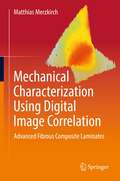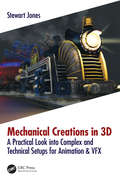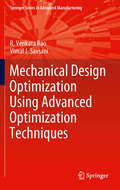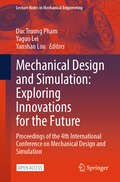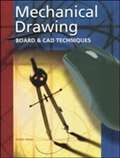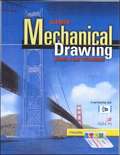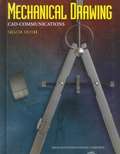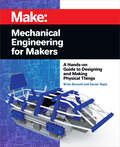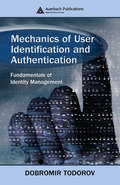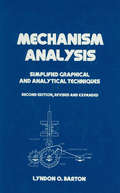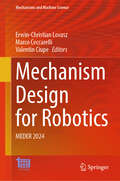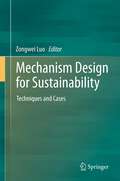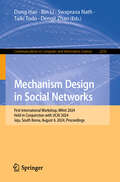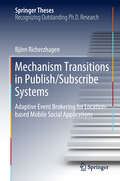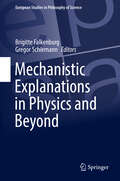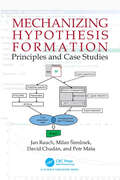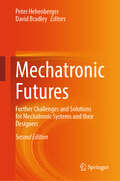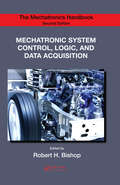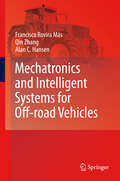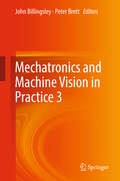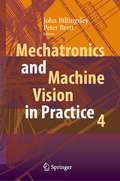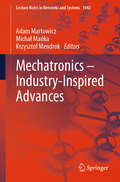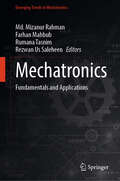- Table View
- List View
Mechanical Characterization Using Digital Image Correlation: Advanced Fibrous Composite Laminates
by Matthias MerzkirchIn this book, a precise treatment of the experimental characterization of advanced composite materials using Digital Image Correlation (DIC) is presented. The text explains test methods, testing setup with 2D- and stereo-DIC, specimen preparation and patterning, testing analysis and data reduction schemes to determine and to compare mechanical properties, such as modulus, strength and fracture toughness of advanced composite materials. Sensitivity and uncertainty studies on the DIC calculated data and mechanical properties for a detailed engineering-based understanding are covered instead of idealized theories and sugarcoated results. The book provides students, instructors, researchers and engineers in industrial or government institutions, and practitioners working in the field of experimental/applied structural mechanics of materials a myriad of color figures from DIC measurements for better explanation, datasets of material properties serving as input parameters for analytical modelling, raw data and computer codes for data reduction, illustrative graphs for teaching purposes, practice exercises with solutions provided online and extensive references to the literature at the end of each stand-alone chapter.
Mechanical Creations in 3D: A Practical Look into Complex and Technical Setups for Animation & VFX
by Stewart JonesCogs, cranks, wheels, plates, chains, springs and pistons - a nightmare for animators. This book shows 3D artists how to create, setup, control and automate movements for complex and technically challenging mechanical structures all while working on a super-detailed steampunk train! This book will specifically implement current industry trends and techniques for animated mechanical structures. We will be using Autodesk 3ds Max only, with no plugins and no additional software required. Readers will close out this book with a completed steampunk train for their portfolios and practical knowledge to combat other tricky hard-surface rigging and animation challenges. <P><P> <P><P>Key Features <li>This is the only book available for mechanical setups in Autodesk 3ds Max. <li>Although 3ds Max specific, the techniques and foundations will work for any 3D application. <li>By following the step-by-step guides in this book, you can finish and complete a portfolio-ready steampunk train. <li>Each chapter will include an introduction and a summary, giving significance to the start and end of each section where readers can rest! <P><P>Boxed step-by-step guides will be used for the creation of technical setups in 3ds Max. A "Memory Refresh" section is included in each chapter, this gives short and quick reminders for the stages needed to complete the chapter setup - helpful as a reference guide for those that have already read the book and just need a reminder, saving them time as they won’t have to re-read the whole thing!
Mechanical Design Optimization Using Advanced Optimization Techniques
by R. Venkata Rao Vimal J. SavsaniMechanical design includes an optimization process in which designers always consider objectives such as strength, deflection, weight, wear, corrosion, etc. depending on the requirements. However, design optimization for a complete mechanical assembly leads to a complicated objective function with a large number of design variables. It is a good practice to apply optimization techniques for individual components or intermediate assemblies than a complete assembly. Analytical or numerical methods for calculating the extreme values of a function may perform well in many practical cases, but may fail in more complex design situations. In real design problems, the number of design parameters can be very large and their influence on the value to be optimized (the goal function) can be very complicated, having nonlinear character. In these complex cases, advanced optimization algorithms offer solutions to the problems, because they find a solution near to the global optimum within reasonable time and computational costs. Mechanical Design Optimization Using Advanced Optimization Techniques presents a comprehensive review on latest research and development trends for design optimization of mechanical elements and devices. Using examples of various mechanical elements and devices, the possibilities for design optimization with advanced optimization techniques are demonstrated. Basic and advanced concepts of traditional and advanced optimization techniques are presented, along with real case studies, results of applications of the proposed techniques, and the best optimization strategies to achieve best performance are highlighted. Furthermore, a novel advanced optimization method named teaching-learning-based optimization (TLBO) is presented in this book and this method shows better performance with less computational effort for the large scale problems. Mechanical Design Optimization Using Advanced Optimization Techniques is intended for designers, practitioners, managers, institutes involved in design related projects, applied research workers, academics, and graduate students in mechanical and industrial engineering and will be useful to the industrial product designers for realizing a product as it presents new models and optimization techniques to make tasks easier, logical, efficient and effective. .
Mechanical Design and Simulation: Proceedings of the 4th International Conference on Mechanical Design and Simulation (Lecture Notes in Mechanical Engineering)
by Duc Truong Pham Yaguo Lei Yanshan LouThis book is an open access publication. This book presents innovative strategies and cutting-edge research at the intersection of mechanical engineering and simulation technologies. Aimed at addressing the current challenges and limitations in mechanical design, this book presents an array of advanced methodologies and tools that promise to revolutionize the field. From integrating artificial intelligence and machine learning for design optimization to leveraging the latest in finite element analysis for enhanced stress modelling, the proceedings highlight the pivotal role of simulation in pushing the boundaries of what is possible in mechanical design. With a strong emphasis on sustainable design practices and the utilization of additive manufacturing, this collection not only serves as an indispensable resource for engineers, researchers, and students but also marks a significant step forward in bridging the gap between traditional mechanical design principles and modern computational innovations.
Mechanical Drawing Board and CAD Techniques (13th Edition)
by Thomas E. French Jay D. HelselThis completely revised comprehensive drafting book for high school includes solid drafting instruction, board drafting techniques, and computer aided drafting techniques. Each chapter provides a large number of practice problems, "Tech Math" incorporating math skills needed for the covered topics, and "Success on the Job" employability skills needed on the job.
Mechanical Drawing: Board & CAD Techniques
by Jay D. HelselProject-based learning prepares students for professional certification with Glencoe Mechanical Drawing: Board and CAD Techniques! Endorsed by the American Design Drafting Association (ADDA), this text includes Prep for ADDA activities. Step-by-step applications, design problems, and drafting problems prepare students for professional excellence and certification. Project-based learning is supported with unit-based projects that integrate technical math and culminate in Build Your Portfolio activities. Help your students get ready for competitive events like the TSA and SkillsUSA with prep activities embedded throughout the content and end-of-chapter assessments. Rigorous academic content is supported, with a special emphasis on math, geometry, and science, with STEM activities. Point-of-use correlations ease possible academic credit application. Extra activities in the Student Edition and workbook help you meet Perkins mandates. The appendix features Math (including algebra and geometry), abbreviations and symbols, pipe symbols, and reference tables (ASME, ANSI, ISO).
Mechanical Drawing: CAD Communications (12th Edition)
by Thomas E. French Jay D. Helsel Carl L. Svensen Byron UrbanickThe nation's #1 drafting text – first published in 1919. The twelfth edition combines basic drafting elements and concepts with modern advancements in the technologies of the industry. Empowers students to move successfully from school to work by helping them visualize in three dimensions, build imaginations, think precisely, and understand the language of the industry.
Mechanical Drawing: CAD Communications (12th Edition)
by Thomas E. French Jay D. Helsel Carl L. Svensen Byron UrbanickThe nation's #1 drafting text – first published in 1919. The twelfth edition combines basic drafting elements and concepts with modern advancements in the technologies of the industry. Empowers students to move successfully from school to work by helping them visualize in three dimensions, build imaginations, think precisely, and understand the language of the industry.
Mechanical Engineering for Makers: A Hands-on Guide to Designing and Making Physical Things
by Brian Bunnell Samer NajiaThis practical, user-friendly reference book of common mechanical engineering concepts is geared toward makers who don't have (or want) an engineering degree but need to know the essentials of basic mechanical elements to successfully accomplish their personal projects. The book provides practical mechanical engineering information (supplemented with the applicable math, science, physics, and engineering theory) without being boring like a typical textbook. Most chapters contain at least one hands-on, fully illustrated, step-by-step project to demonstrate the topic being discussed and requires only common, inexpensive, easily sourced materials and tools. Some projects also provide alternative materials and tools and processes to align with the reader's individual preferences, skills, tools, and materials-at-hand. Linked together via the authors' overarching project -- building a kid-sized tank -- the chapters describe the thinking behind each mechanism and then expands the discussions to similar mechanical concepts in other applications. Written with humor, a bit of irreverence, and entertaining personal insights and first-hand experiences, the book presents complex concepts in an uncomplicated way.Highlights include:Provides mechanical engineering information that includes math, science, physics and engineering theory without being a textbookContains hands-on projects in each chapter that require common, inexpensive, easily sourced materials and toolsAll hands-on projects are fully illustrated with step-by-step instructionsSome hands-on projects provide alternative materials and tools/processes to align with the reader's individual preferences, skills, tools and materials-at-handIncludes real-world insights from the authors like tips and tricks ("Staying on Track") and fail moments ("Lost Track!")Many chapters contain a section ("Tracking Further") that dives deeper into the chapter subject, for those readers that are interested in more details of the topicBuilds on two related Make: projects to link and illustrate all the chapter topics and bring individual concepts together into one systemFurnishes an accompanying website that offers further information, illustrations, projects, discussion boards, videos, animations, patterns, drawings, etc.Learn to effectively use professional mechanical engineering principles in your projects, without having to graduate from engineering school!
Mechanics of User Identification and Authentication: Fundamentals of Identity Management
by Dobromir TodorovUser identification and authentication are absolutely essential to modern security. Mechanics of User Identification and Authentication presents the general philosophy of user authentication and access control. Introducing key concepts, this text outlines the process of controlled access to resources through authentication, authorization, and accounting. It provides specific information on the user authentication process for both UNIX and Windows. Addressing more advanced applications and services, the author presents common security models such as GSSAPI and discusses authentication architecture. Each method is presented with a specific authentication scenario.
Mechanism Analysis: Simplified and Graphical Techniques, Second Edition, (Mechanical Engineering)
by Lyndon O. BartonThis updated and enlarged Second Edition provides in-depth, progressive studies of kinematic mechanisms and offers novel, simplified methods of solving typical problems that arise in mechanisms synthesis and analysis - concentrating on the use of algebra and trigonometry and minimizing the need for calculus.;It continues to furnish complete coverag
Mechanism Design for Robotics: MEDER 2024 (Mechanisms and Machine Science #166)
by Erwin-Christian Lovasz Marco Ceccarelli Valentin CiupeThis book presents the proceedings of the 6th IFToMM Symposium on Mechanism Design for Robotics (MEDER), held in Timişoara, Romania, 27–29 June 2024. It gathers contributions by researchers from several countries on all major areas of robotic research, development and innovation, as well as new applications and current trends. The topics covered include: theoretical and computational kinematics, mechanism design, experimental mechanics, mechanics of robots, control issues of mechanical systems, machine intelligence, innovative mechanisms and applications, linkages and manipulators, micro-mechanisms, dynamics of machinery and multi-body systems. Given its scope, the book offers a source of information and inspiration for researchers seeking to improve their work and gather new ideas for future developments.
Mechanism Design for Sustainability
by Zongwei LuoThis book provides advanced analytics and decision management techniques and tools for developing sustainable competitive advantages in the studied target context. In order to achieve sustainable economy, "the capacity to endure," it is essential to understand and study the mechanisms for interactions and impact from and among these perspectives.
Mechanism Design in Social Networks: First International Workshop, MNet 2024, Held in Conjunction with IJCAI 2024, Jeju, South Korea, August 4, 2024, Proceedings (Communications in Computer and Information Science #2210)
by Bin Li Dengji Zhao Dong Hao Swaprava Nath Taiki TodoThis book constitutes the proceedings of the First International Workshop on Mechanism Design in Social Networks, MNet 2024, held in conjunction with IJCAI 2024, in Jeju, South Korea, on August 4, 2024. The 5 full and 3 short papers included in these proceedings were carefully reviewed and selected from 21 submissions. They focus on providing an internationally respected forum for scientific research tackling the fundamental challenges of mechanism design in social networks.
Mechanism Design: A Linear Programming Approach
by Rakesh V. VohraMechanism design is an analytical framework for thinking clearly and carefully about what exactly a given institution can achieve when the information necessary to make decisions is dispersed and privately held. This analysis provides an account of the underlying mathematics of mechanism design based on linear programming. Three advantages characterize the approach. The first is simplicity: arguments based on linear programming are both elementary and transparent. The second is unity: the machinery of linear programming provides a way to unify results from disparate areas of mechanism design. The third is reach: the technique offers the ability to solve problems that appear to be beyond solutions offered by traditional methods. No claim is made that the approach advocated should supplant traditional mathematical machinery. Rather, the approach represents an addition to the tools of the economic theorist who proposes to understand economic phenomena through the lens of mechanism design.
Mechanism Transitions in Publish/Subscribe Systems
by Björn RicherzhagenThis book reports on a novel concept of mechanism transitions for the design of highly scalable and adaptive publish/subscribe systems. First, it introduces relevant mechanisms for location-based filtering and locality-aware dissemination of events based on a thorough review of the state-of-the-art. This is followed by a detailed description of the design of a transition-enabled publish/subscribe system that enables seamless switching between mechanisms during runtime. Lastly, the proposed concepts are evaluated within the challenging context of location-based mobile applications. The book assesses in depth the performance and cost of transition execution, highlighting the impact of the proposed state transfer mechanism and the potential of coexisting transition-enabled mechanisms.
Mechanistic Explanations in Physics and Beyond (European Studies in Philosophy of Science #11)
by Brigitte Falkenburg Gregor SchiemannThis volume offers a broad, philosophical discussion on mechanical explanations. Coverage ranges from historical approaches and general questions to physics and higher-level sciences . The contributors also consider the topics of complexity, emergence, and reduction. Mechanistic explanations detail how certain properties of a whole stem from the causal activities of its parts. This kind of explanation is in particular employed in explanatory models of the behavior of complex systems. Often used in biology and neuroscience, mechanistic explanation models have been often overlooked in the philosophy of physics. The authors correct this surprising neglect. They trace these models back to their origins in physics. The papers present a comprehensive historical, methodological, and problem-oriented investigation. The contributors also investigate the conditions for using models of mechanistic explanations in physics. The last papers make the bridge from physics to economics, the theory of complex systems and computer science . This book will appeal to graduate students and researchers with an interest in the philosophy of science, scientific explanation, complex systems, models of explanation in physics higher level sciences, and causal mechanisms in science.
Mechanizing Hypothesis Formation: Principles and Case Studies
by Jan Rauch Milan Šimůnek David Chudán Petr MášaMechanizing hypothesis formation is an approach to exploratory data analysis. Its development started in the 1960s inspired by the question “can computers formulate and verify scientific hypotheses?”. The development resulted in a general theory of logic of discovery. It comprises theoretical calculi dealing with theoretical statements as well as observational calculi dealing with observational statements concerning finite results of observation. Both calculi are related through statistical hypotheses tests. A GUHA method is a tool of the logic of discovery. It uses a one-to-one relation between theoretical and observational statements to get all interesting theoretical statements. A GUHA procedure generates all interesting observational statements and verifies them in a given observational data. Output of the procedure consists of all observational statements true in the given data. Several GUHA procedures dealing with association rules, couples of association rules, action rules, histograms, couples of histograms, and patterns based on general contingency tables are involved in the LISp-Miner system developed at the Prague University of Economics and Business. Various results about observational calculi were achieved and applied together with the LISp-Miner system. The book covers a brief overview of logic of discovery. Many examples of applications of the GUHA procedures to solve real problems relevant to data mining and business intelligence are presented. An overview of recent research results relevant to dealing with domain knowledge in data mining and its automation is provided. Firsthand experiences with implementation of the GUHA method in the Python language are presented.
Mechatronic Futures: Further Challenges and Solutions for Mechatronic Systems and their Designers
by David Bradley Peter HehenbergerThis book, a new and revised edition of “Mechatronic Futures”, sets out to identify and discuss the key issues likely to impact on the design and implementation of future mechatronic systems. In doing so, it offers a comprehensive overview of the challenges, risks and options that define the future of mechatronics and provides insights into how these issues are currently being assessed and managed. The book aims to support mechatronics practitioners in identifying key areas in design, modelling and technology and to place these in the wider context of concepts such as cyber-physical systems, Digital Twins and the Internet of Things and alongside issues such as privacy, security and sustainability. For educators, it considers the potential effects of developments in these areas on mechatronic course design, and ways of integrating these. Written by experts in the field, it explores topics including systems integration, design, modelling, privacy, ethics, lifecycle monitoring, sustainability and other potential future application domains. This new edition contains many new chapters as well as updated and revised chapters from the previous edition, and takes into account how recent significant developments in artificial intelligence and cyber-security are changing how current mechatronic systems are designed, manufactured, operated, used and potentially recycled. Highlighting novel innovations and directions, the book is intended for academics, engineers, managers, researchers and students working in the field of mechatronics, particularly those developing new concepts, methods and ideas.
Mechatronic System Control, Logic, and Data Acquisition (The Mechatronics Handbook, Second Edition)
by Robert H. BishopThe first comprehensive and up-to-date reference on mechatronics, Robert Bishop's The Mechatronics Handbook was quickly embraced as the gold standard in the field. With updated coverage on all aspects of mechatronics, The Mechatronics Handbook, Second Edition is now available as a two-volume set. Each installment offers focused coverage of a particular area of mechatronics, supplying a convenient and flexible source of specific information. This seminal work is still the most exhaustive, state-of-the-art treatment of the field available.Focusing on the most rapidly changing areas of mechatronics, this book discusses signals and systems control, computers, logic systems, software, and data acquisition. It begins with coverage of the role of control and the role modeling in mechatronic design, setting the stage for the more fundamental discussions on signals and systems. The volume reflects the profound impact the development of not just the computer, but the microcomputer, embedded computers, and associated information technologies and software advances. The final sections explore issues surrounding computer software and data acquisition. Covers modern aspects of control design using optimization techniques from H2 theoryDiscusses the roles of adaptive and nonlinear control and neural networks and fuzzy systemsIncludes discussions of design optimization for mechatronic systems and real-time monitoring and controlFocuses on computer hardware and associated issues of logic, communication, networking, architecture, fault analysis, embedded computers, and programmable logic controllers
Mechatronics and Intelligent Systems for Off-road Vehicles
by Francisco Rovira Más Alan C. Hansen Qin ZhangRapid developments in electronics over the past two decades have induced a move from purely mechanical vehicles to mechatronics design. Recent advances in computing, sensors, and information technology are pushing mobile equipment design to incorporate higher levels of automation under the novel concept of intelligent vehicles. Mechatronics and Intelligent Systems for Off-road Vehicles introduces this concept, and provides an overview of recent applications and future approaches within this field. Several case studies present real examples of vehicles designed to navigate in off-road environments typically encountered by agriculture, forestry, and construction machines. The examples analyzed describe and illustrate key features for agricultural robotics, such as automatic steering, safeguarding, mapping, and precision agriculture applications. The eight chapters include numerous figures, each designed to improve the reader's comprehension of subjects such as: * automatic steering systems; * navigation systems; * vehicle architecture; * image processing and vision; and * three-dimensional perception and localization. Mechatronics and Intelligent Systems for Off-road Vehicles will be of great interest to professional engineers and researchers in vehicle automation, robotics, and the application of artificial intelligence to mobile equipment; as well as to graduate students of mechanical, electrical, and agricultural engineering.
Mechatronics and Machine Vision in Practice 3
by John Billingsley Peter BrettIn contrast with previous books on mechatronics and machine vision in practice, a significant number of chapters focus on systems designed for human interaction and deciphering human motion. Examples illustrate assistive actuation of hip joints, the augmentation of touch sense in artificial hand prostheses and helping stroke survivors in repetitive motion therapy. Interactive mechatronics and the experience of developing machine interfaces has enabled an examination of how we use mechatronics in the service of training, and even to consider why computer games perhaps appear to capture attention so much more readily than a human instructor! Mechatronics continues to be an exciting and developing field. It is now an essential part of our world and living experience. This and the previous books in this series illustrate the journey in developing the use of mechatronics so far. We anticipate that you will find the chapters here an equal source of inspiration for new devices to solve the challenges of new applications, and of course as a resource for teaching and inspiring the new generation of mechatronics engineers.
Mechatronics and Machine Vision in Practice 4 (Robotics And Mechatronics Ser. #Vol. 4)
by John Billingsley Peter BrettThe many intriguing examples on the application of mechatronics reinforce the excitement of this creative field of technology. As a collection they present a stimulating resource to developers of future mechatronics technology, and to educators searching for interesting examples. From structured-light measurement of the build-up of detritus on railway bogies and detection of uncracked spores of Chinese medicine to a practical tractor vision guidance system embedded in a smart-phone application, the practical applications of mechatronics and machine vision abound. Fruits are counted on the tree, pasture biomass is measured and a robot collects camel dung as a resource. 3D printing is in vogue, but papers here discuss the construction and strategy of the printer itself. The measurement and analysis of myoelectric muscle signals enable a prosthesis to be controlled and a feeding robot is used for patient care. An exoskeleton has both soft and rigid links and an optical sensor analyses the tissue into which a surgical needle is being inserted. These are some of the papers in this collection from the 26th annual conference on Mechatronics and Machine Vision in Practice, carefully selected to exclude papers that are merely theoretical and to highlight those that show practical verification. Papers have been contributed from China, New Zealand, the Philippines, Emirates, Germany and of course Australia.
Mechatronics – Industry-Inspired Advances (Lecture Notes in Networks and Systems #1042)
by Adam Martowicz Michał Mańka Krzysztof MendrokThis book addresses the key aspects concerning the rapid development of mechatronics. It also helps to understand the respective great significance of cooperation between researchers and professionals. Mechatronics is crucial for many areas of life. However, its invaluable contribution is particularly seen in the Fourth Industrial Revolution (Industry 4.0). In response to the current issues in mechatronics, the 6th International Conference Mechatronics 2023: Ideas for Industrial Applications was organized from 11 to 13 December 2023 in Krakow, Poland. The following topics were discussed: artificial intelligence, robotics, image processing, software, control systems, space applications, modeling and identification of mechatronic systems, smart materials, and prototype construction with 3D printing. This book provides the solutions ready for implementation in industry. These solutions grew out of the ideas exchange between the Conference attendees representing various backgrounds.
Mechatronics: Fundamentals and Applications (Emerging Trends in Mechatronics)
by Md. Mizanur Rahman Farhan Mahbub Rumana Tasnim Rezwan Us SaleheenThis book emphasizes on the relevant methodologies that encompass modelling, design approaches, and control of mechatronic systems. In addition, state-of-the-art technologies like artificial intelligence, machine learning, and computational intelligence in mechatronics are explored in this book, illustrating various examples, recent advancements, and case studies from real-world implementations. This book further investigates and unleashes the power of the Internet of Things (IoT), showcasing how it transforms today’s rapidly changing industries by impeccably integrating smart devices and creating interconnected systems. This book serves as a reference tool for students, academics, practitioners, researchers, and industrial leaders in the respective fields.
